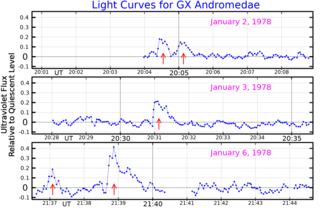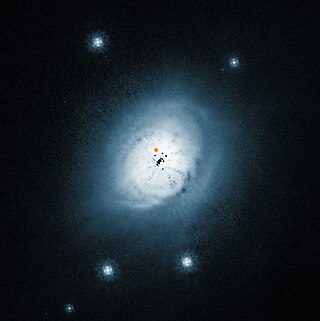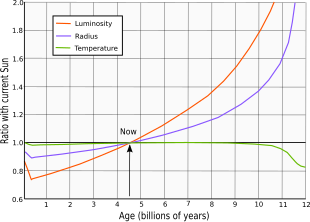
70 Virginis is a binary star located 59 light years from the Sun in the equatorial constellation of Virgo, near the northern constellation border with Coma Berenices. 70 Virginis is its Flamsteed designation. The star is visible to the naked eye as a faint, yellow-hued point of light with an apparent visual magnitude of +4.97. It is drifting further away with a heliocentric radial velocity of +4.4 km/s and has a high proper motion, traversing the celestial sphere at the rate of 0.621 arc seconds per annum.
HD 63454, formally named Ceibo, is a star located in the southern circumpolar constellation Chamaeleon near the border with Mensa. To see the star, one needs a small telescope because it has an apparent magnitude of 9.36, which is below the limit for naked eye visibility. The object is located relatively close at a distance of 123 light years based on Gaia DR3 parallax measurements but is receding with a heliocentric radial velocity of 33.8 km/s. At its current distance, HD 63454's brightness is diminished by two tenths of a magnitude due to interstellar dust. It has an absolute magnitude of +6.68.

Groombridge 34 is a binary star system in the northern constellation of Andromeda. It was listed as entry number 34 in A Catalogue of Circumpolar Stars, published posthumously in 1838 by British astronomer Stephen Groombridge. Based upon parallax measurements taken by the Gaia spacecraft, the system is located about 11.6 light-years from the Sun. This positions the pair among the nearest stars to the Solar System.

Zeta Tucanae, Latinized from ζ Tucanae, is a star in the constellation Tucana. It is a spectral class F9.5 main sequence star with an apparent magnitude of +4.23. Despite having a slightly lower mass, this star is more luminous than the Sun. Based upon parallax measurements by the Hipparcos spacecraft, it is approximately 28.0 light years from Earth. This is one of the least variable stars observed during the Hipparcos mission.
20 Leonis Minoris is a binary star system in the northern constellation of Leo Minor. It is faintly visible to the naked eye, having an apparent visual magnitude of +5.4. Based upon an annual parallax shift of 66.46 mas, it is located 49 light years from the Sun. The star has a relatively high proper motion and is moving away from the Sun with a radial velocity of +56 km/s. The system made its closest approach about 150,000 years ago when it came within 32.2 ly (9.86 pc).

HD 100546, also known as KR Muscae, is a pre-main sequence star of spectral type B8 to A0 located 353 light-years from Earth in the southern constellation of Musca. The star is surrounded by a circumstellar disk from a distance of 0.2 to 4 AU, and again from 13 AU out to a few hundred AU, with evidence for a protoplanet forming at a distance of around 47 AU.
36 Ursae Majoris is a double star in the northern constellation of Ursa Major. With an apparent visual magnitude of 4.8, it can be seen with the naked eye in suitable dark skies. Based upon parallax measurements, this binary lies at a distance of 42 light-years from Earth.
HD 165259, also known as HR 6751 is a triple star system located in the southern circumpolar constellation of Apus. It has an apparent magnitude of 5.86, making it faintly visible to the naked eye Parallax measurements place the system at a distance of 138 light years, and it is currently receding with a heliocentric radial velocity of 13.1 km/s.

HD 114613 is a fifth magnitude yellow subgiant that lies 66.7 light-years away in the constellation of Centaurus. The star may be host to a long-period giant planet.
Xi Pegasi is the Bayer designation for a double star in the northern constellation of Pegasus, the winged horse. Located in the horse's neck, the primary component is an F-type main sequence star that is visible to the naked eye with an apparent visual magnitude of 4.2. It is 86% larger and 17% more massive that the Sun, radiating 4.5 times the solar luminosity. Based upon parallax measurements taken with the Hipparcos spacecraft, it is located 53.2 ± 0.2 light years from the Sun.
Gliese 221, also known as BD-06 1339, is a star with an exoplanetary companion in the equatorial constellation of Orion. It is too faint to be visible to the naked eye, having an apparent visual magnitude of 9.70 and an absolute magnitude of 8.15. Using parallax measurements, the distance to this system can be estimated as 66.2 light-years. It is receding from the Sun with a radial velocity of +23 km/s. This is a high proper motion star, traversing the celestial sphere at an angular rate of 0.333″·yr−1.
HD 168009 is a star in the northern constellation of Lyra. It has an apparent visual magnitude of 6.3, placing it just above to below the normal limit of stars visible to the naked eye under good viewing conditions of 6-6.5. An annual parallax shift of 42.93 mas provides a distance estimate of 76 light years. It is moving closer to the Sun with a heliocentric radial velocity of −65 km/s. In about 328,000 years from now, the star will make its closest approach at a distance of around 17 ly (5.1 pc).

HD 111395 is a single, variable star in the northern constellation of Coma Berenices. It has the variable star designation LW Com, short for LW Comae Berenices; HD 111395 is the Henry Draper Catalogue designation. The star has a yellow hue and is just bright enough to be barely visible to the naked eye with an apparent visual magnitude that fluctuates around 6.29. Based upon parallax measurements, it is located at a distance of 55.8 light years from the Sun. The star is drifting closer with a radial velocity of −8.9 km/s. It is a member of the Eta Chamaeleontis stellar kinematic group.
HD 46588 is a star in the northern circumpolar constellation Camelopardalis. It has an apparent magnitude of 5.44, allowing it to be faintly seen with the naked eye. The object is relatively close at a distance of only 59 light years but is receding with a heliocentric radial velocity of 15 km/s.

19 Leonis Minoris is a spectroscopic binary located in the northern constellation Leo Minor. It has an apparent magnitude of 5.1, making it one of the brighter members of the constellation. The system is relatively close at a distance of 94 light years but is drifitng closer with a heliocentric radial velocity of 8.6 km/s.









